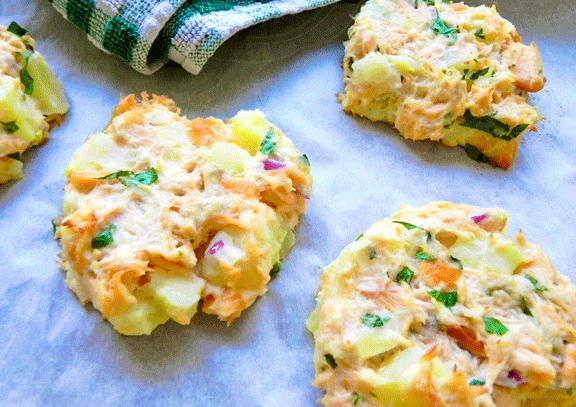
The idea is that you put in a little extra effort on the first day (cook once), but prepare dishes for two meals (eat twice), like these patties.
By Kathryn MacLean
Are you trying to stay on top of preparing dinners, and maybe even lunches, too? You may have already heard the idea of “cook once, eat twice.”
That means if you’re already planning to make lasagna, make two lasagnas and freeze one, for example. Or bake double the amount of chicken thighs you need for dinner, and pack the rest away in the fridge for later in the week.
The idea is that you put in a little extra effort on the first day (cook once), but prepare dishes for two meals (eat twice). This works well with dishes that can be frozen or that you don’t mind eating twice in a week. It’s a good way to plan your week if you’re cooking for one or two rather than a hungry family.
I’m going to give a few cook-once dish suggestions. But a variation on this system is to prepare a base of grains (like quinoa, rice, barley) or carbs (potatoes, pasta) to use in different ways throughout the week.
Whether for one, or one family, you can use the grains in different ways. Cooking them plain, once, and having them to draw from means you can take advantage of having something halfway ready.
Consider making a pot of quinoa one day. Start with bringing 2 cups of water to boiling, add 1 cup of rinsed quinoa, reduce the heat, cover and simmer for 15 minutes. Serve some of that quinoa for your meal. As a side as is or mixed with quickly steamed frozen peas, etc.
Store the remaining (plain) cooked grains in the fridge. When you pack your lunch or plan your dinner over the next few days, you can draw from the quinoa. Maybe as the base for a grain bowl, topped with assorted veggies, protein, seeds and dressing.
If you have more days and more quinoa, try a quinoa salad. Or just add quinoa to a salad. Or simply add soy sauce, or mixed herbs and use it as a different side dish.
When you make extra rice, you don’t have to eat the leftovers in the same way.
Make fried rice with soy or fish sauce and chopped veggies.
Or a rice salad with jarred pickled veggies and fresh herbs.
Do you make pasta pretty regularly for dinner?
Cook an extra couple of servings next time.
Once you drain the pasta, take the extra servings aside, toss with olive oil, and store, covered, in the fridge.
After dinner (or within the next couple days), add any of chopped raw or cooked veggies, shredded cheese, jarred olives, fresh herbs, and dressing to make a pasta salad.
Now, a few ideas for bigger dishes.
As mentioned, lasagna or other baked pasta dishes. But there are variations to simply having double the same dish.
A whole chicken… or two, if the size of your family warrants that.
The first chicken can be served hot, for dinner on day one.
The second chicken can be divided into one or more additional dishes.
Use some of the spare chicken to make chicken salad (with mayo and chopped celery) for sandwiches. Shred some for quesadillas or tacos. Add to soup, or noddle dishes.
Fish: when you cook fish, add extra for later.
Add the leftover fish to a dish with cooked and lightly mashed potatoes, plus any of onion, herbs, and chopped veggies. Mix with an egg and an egg white.
Shape into patties and bake on a parchment-lined sheet pan at 425 for 15-20 minutes.
Fish cakes for lunches or another (slightly different) dinner!
You can even use extra burgers in a new way.
Cook a few spares next time you’re making burgers, and put them aside in the fridge for 2-3 days.
When you’re ready, break them up with a spatula while reheating in a pan with a couple spoons of simmering water.
Add taco-style seasoning and use the pieces in quesadillas, or on nachos.
Add ginger and garlic, any veggies you want and add to a packaged noodle dish (like instant ramen).
Add canned tomatoes and herbs, or jarred tomato sauce and serve with pasta.
Some ‘cook once eat twice’ dishes are strictly eat twice, like a frozen lasagna.
But others that require a little work still offer a shortcut to additional meals.
I think the shortcuts are still worthwhile.
The second dishes come together much faster than starting from scratch, and save you the trip (and cost) of picking something up for takeout.
Even if it’s just a couple of packed lunches rather than a second dinner, wouldn’t you like some ease in your week?
